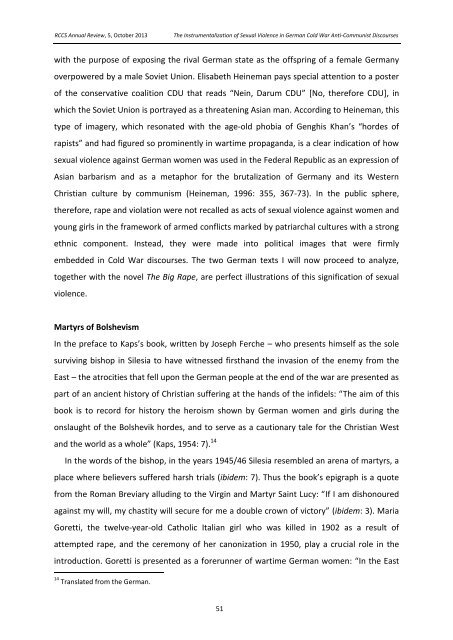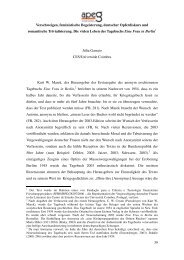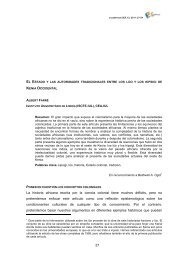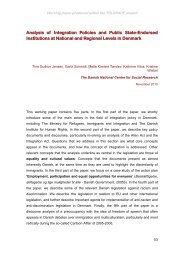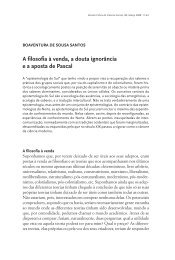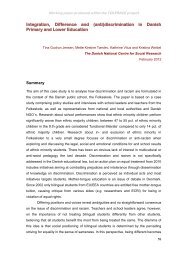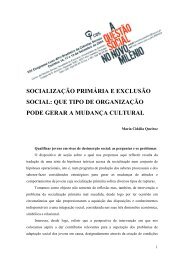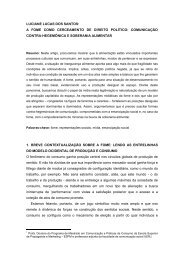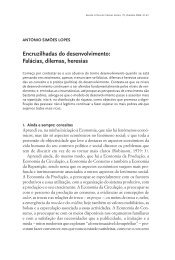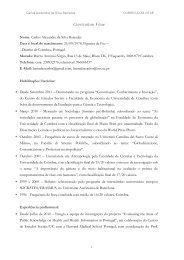The Instrumentalization of Sexual Violence in German Cold War Anti ...
The Instrumentalization of Sexual Violence in German Cold War Anti ...
The Instrumentalization of Sexual Violence in German Cold War Anti ...
Create successful ePaper yourself
Turn your PDF publications into a flip-book with our unique Google optimized e-Paper software.
RCCS Annual Review, 5, October 2013<br />
<strong>The</strong> <strong>Instrumentalization</strong> <strong>of</strong> <strong>Sexual</strong> <strong>Violence</strong> <strong>in</strong> <strong>German</strong> <strong>Cold</strong> <strong>War</strong> <strong>Anti</strong>-Communist Discourses<br />
with the purpose <strong>of</strong> expos<strong>in</strong>g the rival <strong>German</strong> state as the <strong>of</strong>fspr<strong>in</strong>g <strong>of</strong> a female <strong>German</strong>y<br />
overpowered by a male Soviet Union. Elisabeth He<strong>in</strong>eman pays special attention to a poster<br />
<strong>of</strong> the conservative coalition CDU that reads “Ne<strong>in</strong>, Darum CDU” [No, therefore CDU], <strong>in</strong><br />
which the Soviet Union is portrayed as a threaten<strong>in</strong>g Asian man. Accord<strong>in</strong>g to He<strong>in</strong>eman, this<br />
type <strong>of</strong> imagery, which resonated with the age-old phobia <strong>of</strong> Genghis Khan’s “hordes <strong>of</strong><br />
rapists” and had figured so prom<strong>in</strong>ently <strong>in</strong> wartime propaganda, is a clear <strong>in</strong>dication <strong>of</strong> how<br />
sexual violence aga<strong>in</strong>st <strong>German</strong> women was used <strong>in</strong> the Federal Republic as an expression <strong>of</strong><br />
Asian barbarism and as a metaphor for the brutalization <strong>of</strong> <strong>German</strong>y and its Western<br />
Christian culture by communism (He<strong>in</strong>eman, 1996: 355, 367-73). In the public sphere,<br />
therefore, rape and violation were not recalled as acts <strong>of</strong> sexual violence aga<strong>in</strong>st women and<br />
young girls <strong>in</strong> the framework <strong>of</strong> armed conflicts marked by patriarchal cultures with a strong<br />
ethnic component. Instead, they were made <strong>in</strong>to political images that were firmly<br />
embedded <strong>in</strong> <strong>Cold</strong> <strong>War</strong> discourses. <strong>The</strong> two <strong>German</strong> texts I will now proceed to analyze,<br />
together with the novel <strong>The</strong> Big Rape, are perfect illustrations <strong>of</strong> this signification <strong>of</strong> sexual<br />
violence.<br />
Martyrs <strong>of</strong> Bolshevism<br />
In the preface to Kaps’s book, written by Joseph Ferche – who presents himself as the sole<br />
surviv<strong>in</strong>g bishop <strong>in</strong> Silesia to have witnessed firsthand the <strong>in</strong>vasion <strong>of</strong> the enemy from the<br />
East – the atrocities that fell upon the <strong>German</strong> people at the end <strong>of</strong> the war are presented as<br />
part <strong>of</strong> an ancient history <strong>of</strong> Christian suffer<strong>in</strong>g at the hands <strong>of</strong> the <strong>in</strong>fidels: “<strong>The</strong> aim <strong>of</strong> this<br />
book is to record for history the heroism shown by <strong>German</strong> women and girls dur<strong>in</strong>g the<br />
onslaught <strong>of</strong> the Bolshevik hordes, and to serve as a cautionary tale for the Christian West<br />
and the world as a whole” (Kaps, 1954: 7). 14<br />
In the words <strong>of</strong> the bishop, <strong>in</strong> the years 1945/46 Silesia resembled an arena <strong>of</strong> martyrs, a<br />
place where believers suffered harsh trials (ibidem: 7). Thus the book’s epigraph is a quote<br />
from the Roman Breviary allud<strong>in</strong>g to the Virg<strong>in</strong> and Martyr Sa<strong>in</strong>t Lucy: “If I am dishonoured<br />
aga<strong>in</strong>st my will, my chastity will secure for me a double crown <strong>of</strong> victory” (ibidem: 3). Maria<br />
Goretti, the twelve-year-old Catholic Italian girl who was killed <strong>in</strong> 1902 as a result <strong>of</strong><br />
attempted rape, and the ceremony <strong>of</strong> her canonization <strong>in</strong> 1950, play a crucial role <strong>in</strong> the<br />
<strong>in</strong>troduction. Goretti is presented as a forerunner <strong>of</strong> wartime <strong>German</strong> women: “In the East<br />
14 Translated from the <strong>German</strong>.<br />
51


